Dentist-approved remedies for sensitive teeth
Do your teeth start to hurt when you eat or drink hot, cold, sweet, or acidic foods? This sensation may indicate you have sensitive teeth. About 40 million Americans have sensitive teeth, making it one of the most widespread dental complaints, according to the Academy of General Dentistry.
“The primary reason for sensitive teeth is the enamel that covers the tooth is worn away or gets so thin the dentin is exposed,” says Ronald P. Burakoff, DMD, chair of dental medicine at North Shore University Hospital in Manhasset, New York and Long Island Jewish Medical Center in New Hyde Park, New York. The enamel has no nerves, but, dentin, which is the layer beneath the enamel does, explains the American Dental Association (ADA). This erosion, in turn, can be caused by many different things, including grinding your teeth brushing the wrong way or eating too many acidic foods. Other possible causes for sensitive teeth include cavities, fractured teeth, worn filling, gum disease, and exposed tooth root. Here are some oral hygiene tips for healthy, white teeth.
“While generalized sensitivity isn’t necessarily a sign of great evil afoot, it’s not a good thing because if your teeth are generally sensitive, you’re not going to brush like you should because it’s uncomfortable,” says Matthew Messina, DDS, ADA spokesperson and a faculty member at the Ohio State University College of Dentistry in Columbus. “You need to look for solutions.”
To prevent or minimize the damage, here are dentist-approved home remedies to ease the pain.
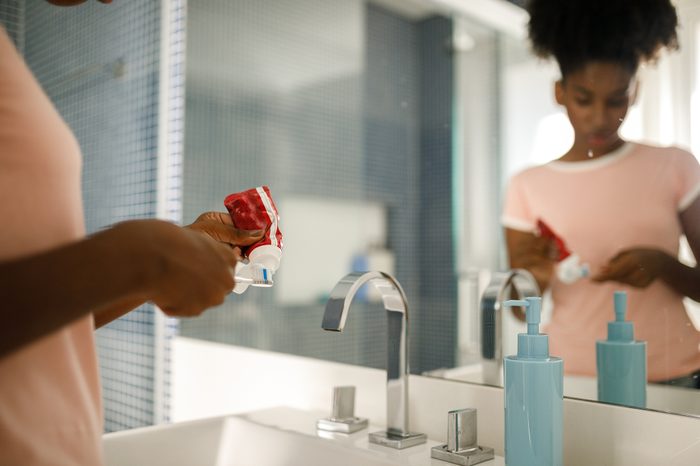
Try a desensitizing toothpaste
If you’re sure that no underlying problems like a cavity or fractured tooth are causing your sensitivity, desensitizing toothpaste is a great first line of defense, says Dr. Messina.
There are two types of desensitizing toothpaste. One type contains potassium nitrate. Potassium dulls the receptors in any exposed nerve endings in the dentin, says Janna Burnett, DDS, clinical assistant professor, department of comprehensive dentistry, Texas A&M College of Dentistry, Dallas. “You have to use it daily and it doesn’t last long,” she adds. “It’s not a longer-term fix. It’s something you have to keep up with.” (Most at-home remedies do take a while to start working, adds Dr. Messina.)
Other kinds of desensitizing toothpaste use a variety of different materials to plug up the dentinal tubules, Dr. Burnett says. The dentin layer of your tooth is flecked with small tubules or pores, each of which have a nerve ending, she explains.
“It isn’t an instant fix,” says Dr. Messina. “It takes steady use for several days to weeks to start to clog up those holes so the teeth aren’t sensitive.” And if you stop using it, the sensitivity will return.
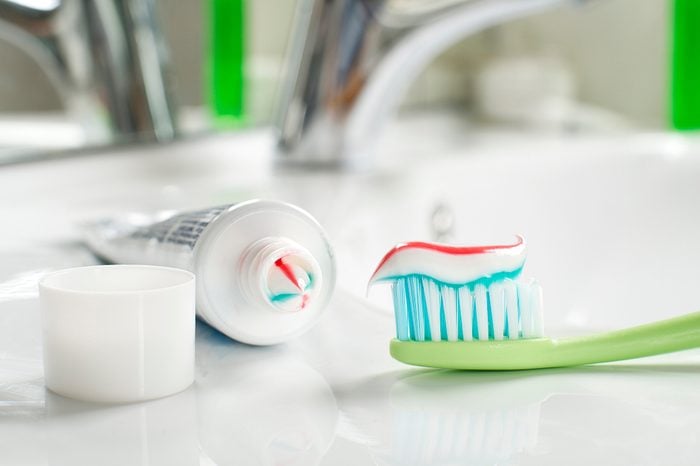
Use fluoride
Whatever toothpaste you use—desensitizing or not—look for products containing fluoride. Fluoride is a mineral that strengthens the outer, enamel layer of your teeth, making them less prone to cavities, says the ADA. And that helps cut down on sensitivity.
“Good old fluoride in toothpaste changes the structure of the enamel and decreases sensitivity,” says Dr. Burakoff.
Most toothpaste and mouthwash these days have fluoride in them. Look for the ADA seal of approval to confirm. You’ll also find fluoride in drinking water (though not usually in bottled water) and you’ll likely get a fluoride treatment when you have your regular dentist visit. This one will be stronger than the fluoride you’ll find in over-the-counter products.
“When you go to the dentist every six months, they will usually offer you a fluoride varnish which is really helpful,” says Dr. Burnett. “It’s a sticky material and fluoride is reinforcing the hardness of your teeth.”
There are also prescription fluoride supplements, in the form of tablets, lozenges or drops, although the ADA recommends these only for children six months to 16 years who don’t have access to enough fluoride in their drinking water and who are also prone to cavities. Talk to your doctor about whether this type of product might also help you.
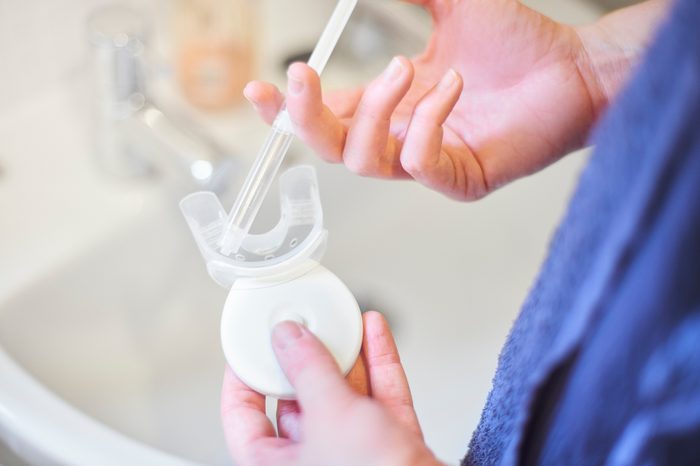
Be cautious with whitening products
While products with fluoride may help reduce sensitivity, whiteners can work in the opposite direction, says Dr. Messina. This includes toothpaste containing baking soda and peroxide. (Follow these dentist tips for safe teeth whitening.)
“They’re trying to bubble off the stain and open up the teeth so for someone who has sensitive teeth, it may make the tooth more sensitive,” he says.
Adds Dr. Burnett, “It can dehydrate your teeth. If you’re fluid out of the little pores or tubules, that will elicit a response from the nerve endings and they’re not going to like it.”
That doesn’t mean you can’t partake of whitening technology if you happen to have sensitive teeth, just that you might have to go about it a different way, Messina says. “We may act to reduce the sensitivity first and then do the whitening,” he says.
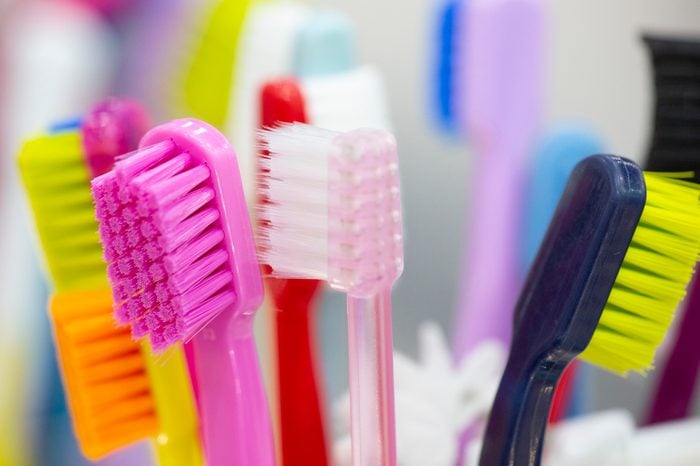
Choose the right toothbrush
This means one that’s soft-bristled, not medium and not hard. “A hard-bristled brush may feel like you’re getting your teeth cleaner, but it’s actually doing quite a bit of abrasion and abrading the enamel off,” says Dr. Burnett. A soft-bristled brush is also less likely to irritate the gums.
Make sure you keep an eye on the life span of your brush. Once the bristles start to separate, get a new one, probably every three or four months or sooner, recommends the ADA.
Electric toothbrushes can also be a good option. “If you look at the research, they tend to clean teeth better and a lot of them have a built-in two-minute timer so you get the benefit of brushing for the full two minutes,” says Dr. Burnett. Here are electric toothbrushes dentists recommend.

Improve your brushing technique
Just as you don’t want a toothbrush with hard bristles, you also don’t want to scrub your teeth like the fate of the world depends on it.
“If we’re brushing aggressively and using something other than a soft or ultra-soft toothbrush, it can wear away at the gum tissue around the teeth,” says Dr. Messina. While the top of your teeth don’t have any nerve endings, the portions below the gum do. Beating back your gums means those areas are exposed.
Instead, you want more of a massage. Brush in little circles instead of back-and-forth so you get under the gum line, advises Dr. Burnett. This actually helps get two to three millimeters ‘under’ the gum tissue to break up the biofilm or bacteria,” she adds.
Even the best brush job won’t clear away everything so floss the areas between the teeth and below the gum line. “You’re mechanically removing food and plaque,” Dr. Messina adds. “That keeps the gums healthy and healthy gums don’t recede.”
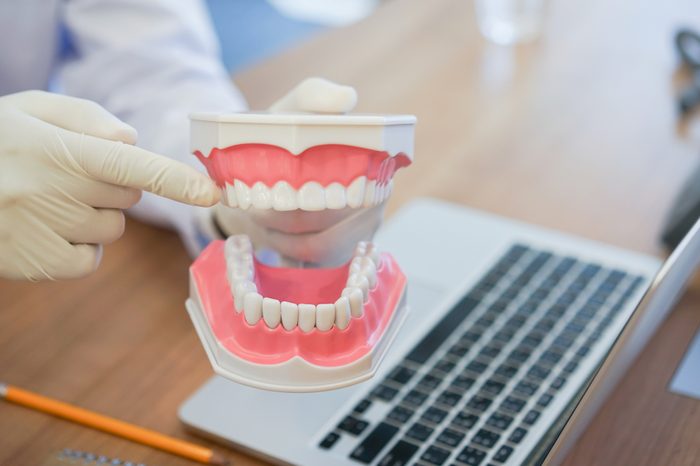
Take steps to avoid gum disease
Good oral hygiene habits will help keep periodontal (gum) disease, which can contribute to sensitive teeth, at bay. Without proper brushing and flossing (not to mention regular visits to the dentist), bacteria from food will gather around your teeth and harden into tartar which starts to push back your gums and expose the nerves, says the ADA. Other factors can play into gum disease as well. This includes using tobacco, oral piercings, and some hormonal changes in females.
Symptoms of gum disease other than sensitive teeth include red, swollen, bleeding or painful gums, pain when you chew, loose teeth, persistent bad breath and retreating gums, says the National Institute for Dental and Craniofacial Research (NIDCR).
Dry mouth can also lead indirectly to sensitive teeth. “The bacteria that prefer a dry mouth are some of our more aggressive ones and without the buffering and washing action of enough saliva, the risk of dental decay (cavities) goes up, which leads to increased sensitivity,” explains Dr. Messina.

Avoid acidic foods and drinks
Consuming foods and beverages high in acidic foods can also contribute to sensitive teeth. “Acid dissolves away tooth enamel, opens up the tubules and makes the teeth more sensitive,” says Dr. Messina.
So what types of items are acidic? Things that taste sour, says Dr. Messina. That includes lemons and other citrus fruits as well as tomatoes and pickles. Carbonated beverages (regular and diet) are also high in acid, as are tea and coffee. And some supposedly healthy items, like kombucha, have a lot of acid, says Dr. Burnett. Beware also of vinegar cleanses.
Certain medical conditions can also increase acid levels in your mouth, including gastric reflux, anorexia, bulimia and ulcers, says Dr. Burnett. Beware of mouthwashes that contain acid as they can aggravate sensitivity. Limiting acidic items should also help to cut down on cavities, says Dr. Burakoff.
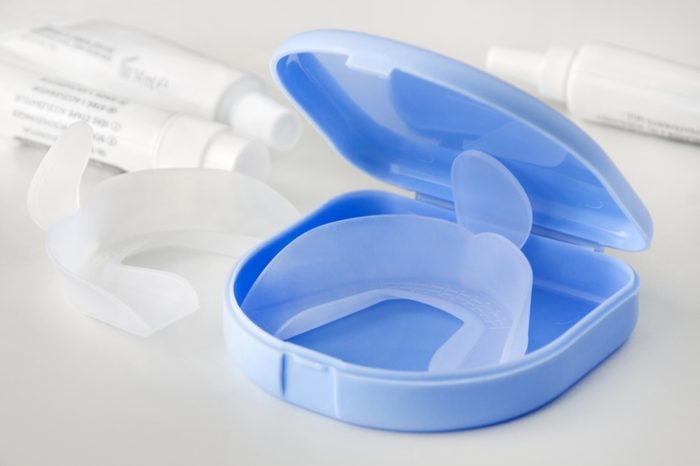
Wear a mouth guard
If you grind your teeth, which is known as bruxism, talk to your dentist about a mouth guard as this can also erode enamel and expose the more sensitive dentin layer of your tooth. Individuals with this issue not only grind their teeth at night, but may also clench them during the day. Both habits can be damaging to the enamel. And if you’ve lost enamel from consuming acidic foods and beverages, the grinding and clenching can make it even worse, says Dr. Burnett.
Since much of bruxism occurs while you’re asleep, you may not even know you’re doing it. Sensitive teeth can be one symptoms but be aware of others as well, such as chipped or loose teeth, strained jaw muscles, soreness in. Your jaw, neck or pain, pain that extends to your ear and a headache. It’s unclear what causes bruxism, but stress, age, a family history and some other medical conditions (like epilepsy and sleep apnea) increase the risk.
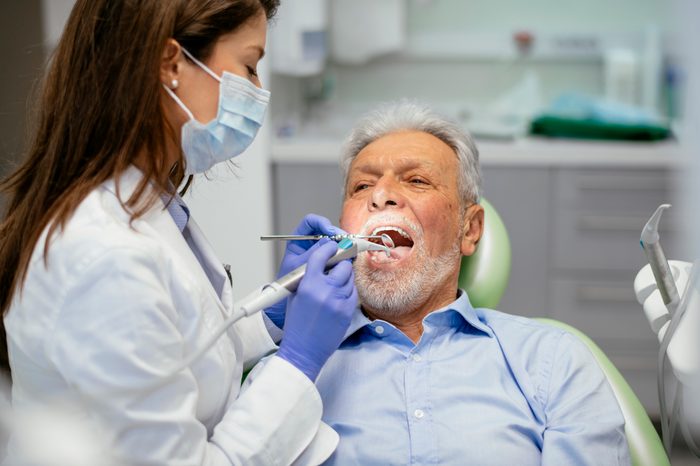
“Barrier” treatments
If over-the-counter remedies aren’t easing tooth sensitivity, there are several different procedures your dentist (or a hygienist) can do
So-called “barrier” treatments are ones usually done in a dentist’s office to physically plug up any exposed pores, explains Dr. Burnett. “There’s a wide range of products [which] last much longer than anything over-the-counter.”
Bonding, one subtype of barrier treatment, uses tooth-colored filling material. Dentists may also use fluoride-releasing resin material (a cousin of the tooth-colored filling), says Dr. Burnett. Regular composite fillings may also be used.
“The logic is similar [to some over-the-counter remedies] in that this is physically plugging up the tubules, but different than, say, the sensitivity toothpaste where little precipitates are traveling into the tubules to create a plug,” says Dr. Burnett. “This is more of a ‘shield’ than a ‘plug’ because it covers the entire surface of where it’s applied.”

Surgical gum grafts
Gum grafting, also called a gingival graft, is another procedure performed by your dentist in his or her office. It involves taking tissue from somewhere else in your mouth (like your palate) and grafting it onto the area or areas that are sensitive, according to the American Academy of Periodontology (AAP).
“Sometimes the roots are exposed,” says Dr. Burakoff. “You can do grafting with soft tissue (for example, from the palate) to cover the roots.”
According to the AAP, not only can this resolve sensitivity, it may also prevent additional bone loss or gum recession. “We only get so much bone around teeth when it goes away it doesn’t come back,” says Dr. Messina.
The downside, points out Dr. Burakoff, is that the procedure can be invasive and costly.
If deep cavities are causing tooth cavities, then you may need a root canal, says Dr. Burakoff. That’s when a dentist goes into the pulp tissue below the dentin to clean it out and seal it, explains the American Association of Endodontists.

See a dentist regularly
You can often tell the difference between sensitive teeth and pain from a cavity or another problem. Sensitivity tends to affect all or most of your teeth while a cavity is more localized, explains Dr. Messina. Tooth sensitivity tends to be a “short, sharp pain,” says Dr. Burnett. “That’s different than a toothache that is more likely a dull, throbbing pain that wakes you up in the middle of the night.” Sensitive teeth also tend to be activated by some kind of stimulus, like hot or cold temperature or brushing.
Still, there are other causes of pain and sensitivity that can be confused with sensitivity, which is why you should get regular check-ups with a dentist, says Dr. Burnett.
The ADA doesn’t recommend a specific number of dentist visits a year, instead, recognizing that some people need to go only once or twice a year and some more often. (Here are some tips on dental etiquette.)
